micro lab report carbohydrate test, nitrate, and urea
1/30
There's no tags or description
Looks like no tags are added yet.
Name | Mastery | Learn | Test | Matching | Spaced |
|---|
No study sessions yet.
31 Terms
bacteria A is known to use glucose and sucrose carbohydrates.
when inoculated into TSIA and after using all available glucose and sucrose, bacteria A will use peptones *********** of the TSIA tube. T/F
false
the durham tube within TSIA will collect any CO2 production by the bacteria. T/F
false
while viewing results of the nitrate reduction test, you are told that nitrate reagents A and B were added to the inoculated broth. you are not told if zinc dust was added or not. if the broth is red, you can conclude:
none of the above
wrong:
-the organism is nitrate reductase positive and nitrite reductase positive
-the organism is nitrate reductase positive
-the organism is nitrate reductase negative
TSIA is strategically made with differing quantities of these three sugars: 0.1% glucose, 1.0% lactose, and 1.0% sucrose. This is the standard recipe used for testing.
consider a situation where we altered the recipe to be 2% glucose, 0.1% lactose, and 0.1% sucrose. if you inoculated a saccharolytic bacteria in this altered TSIA recipe, what might you expect the results to be for 1) a bacteria that uses glucose only and 2) a bacteria that uses glucose, lactose, and sucrose? how does this compare to the results you would expect in the standard TSIA recipe? would altering this recipe be a good or bad idea in practice?
Hint: in your answer, you should consider what the standard recipe accomplishes and how the altered recipe may change your interpretation of observed results. this is a challenging question: take your time, think through it step-by-step, and try your best.
first off, saccharolytic means that it consumes glucose, which I presume would be the first carbohydrate that the bacteria would eat in the new recipe of 2% glucose, since the lactose and sucrose would be converted into a form of glucose later. if the bacteria only eat glucose, then one would expect there to be a quicker color change to a yellow bottom and a red top, facultative anaerobe, since there is an abundance of glucose present. there will be less red in the bacteria tube that only eats glucose, then the normal recipe, since it's primarily glucose. there may also be cracks in the medium since the bacteria is saccharolytic, and the bubbles/cracks will be the CO2 gas. if the bacteria eats all three carbohydrates, then one would expect the tube to turn a yellow, which is the acidic indicator. this yellow may not be as bright as usual, since the bacteria consumed so much of the glucose in the first 18-24 hours of fermentation. the original recipe allows for the organism to either ferment all three sugars, only glucose, or neither lactose or sucrose. the small amount of glucose in the original recipe allows it to be consumed quickly, so that the other carbohydrates can show whether they were consumed or not afterwards. less glucose in the recipe allows scientists to focus on whether the other two sugars were consumed with or without glucose too.
there are three sugars within TSIA. which sugars are present in the same percentage? select all that apply.
-lactose
-sucrose
the phenol red carbohydrate broth family is a family of broths which consist of a sugar (a substrate) and __ (an indicator). these broths are a type of __ microbiological growth medium. sometimes a __ is include to detect the production of __, such as in our glucose broths.
when the bacteria utilize the carbohydrate __ by-products are released, leading to a/an __ in pH and the media turns __. this __ result is represented by an A (acidic) or A+G if gas is present.
if the bacteria doesn't utilize the carbohydrate, it utilizes __ instead, leading to a/an __ in the pH and the media turns __. this negative result is represented by a K (alKaline).
the phenol red carbohydrate broth family is a family of broths which consist of a sugar (a substrate) and phenol red (an indicator). these broths are a type of differential microbiological growth medium. sometimes a durham tube is include to detect the production of carbon dioxide, such as in our glucose broths.
when the bacteria utilize the carbohydrate acidic by-products are released, leading to a/an decrease in pH and the media turns yellow. this positive result is represented by an A (acidic) or A+G if gas is present.
if the bacteria doesn't utilize the carbohydrate, it utilizes proteins instead, leading to a/an increase in the pH and the media turns a darker red. this negative result is represented by a K (alKaline).
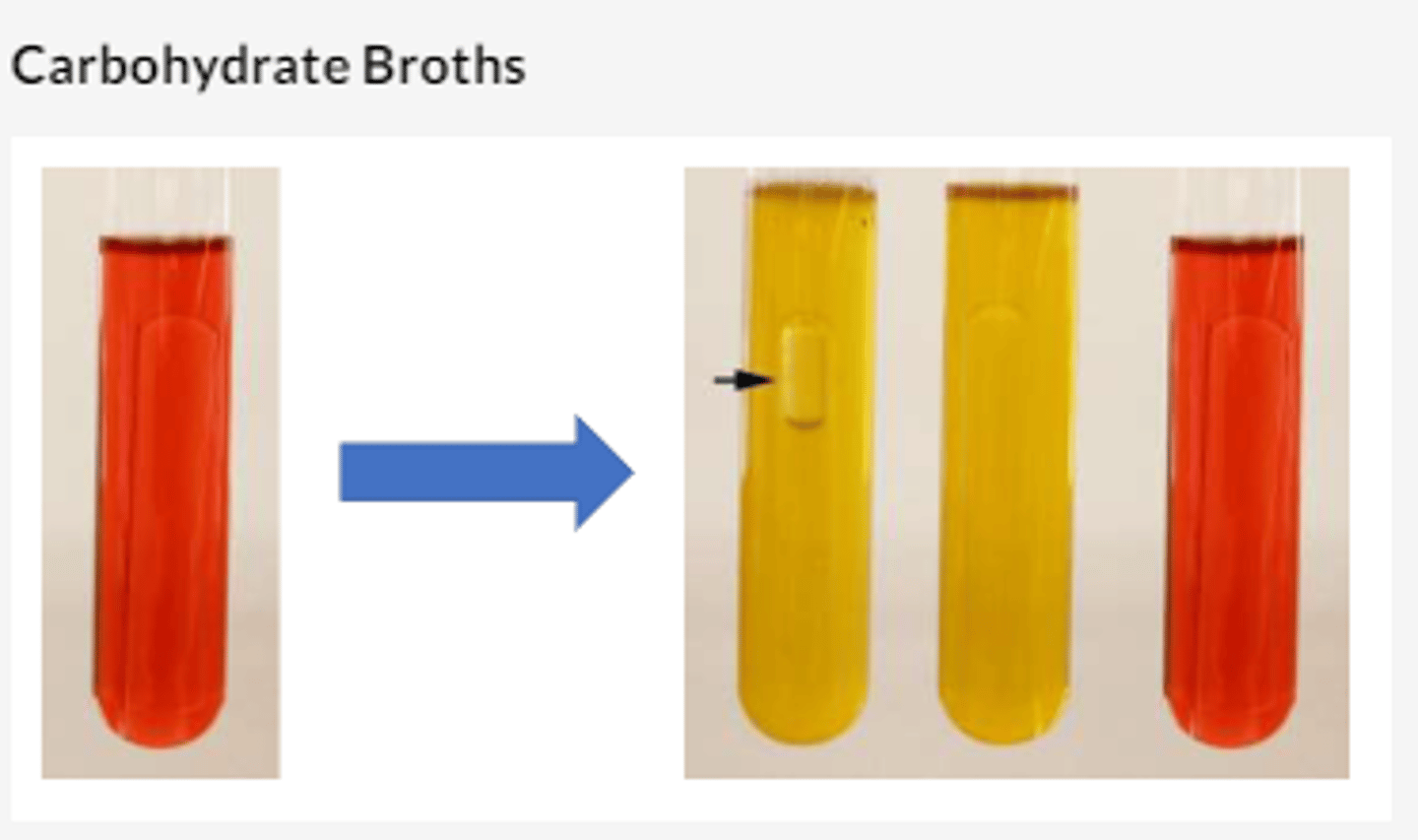
after 24 hours of incubation, your urea broth results are pictured with an uninoculated control on the left.
the right urea broth tube is a __ reaction, indicating __ pH conditions
the right urea broth tube is a positive reaction, indicating alkaline pH conditions
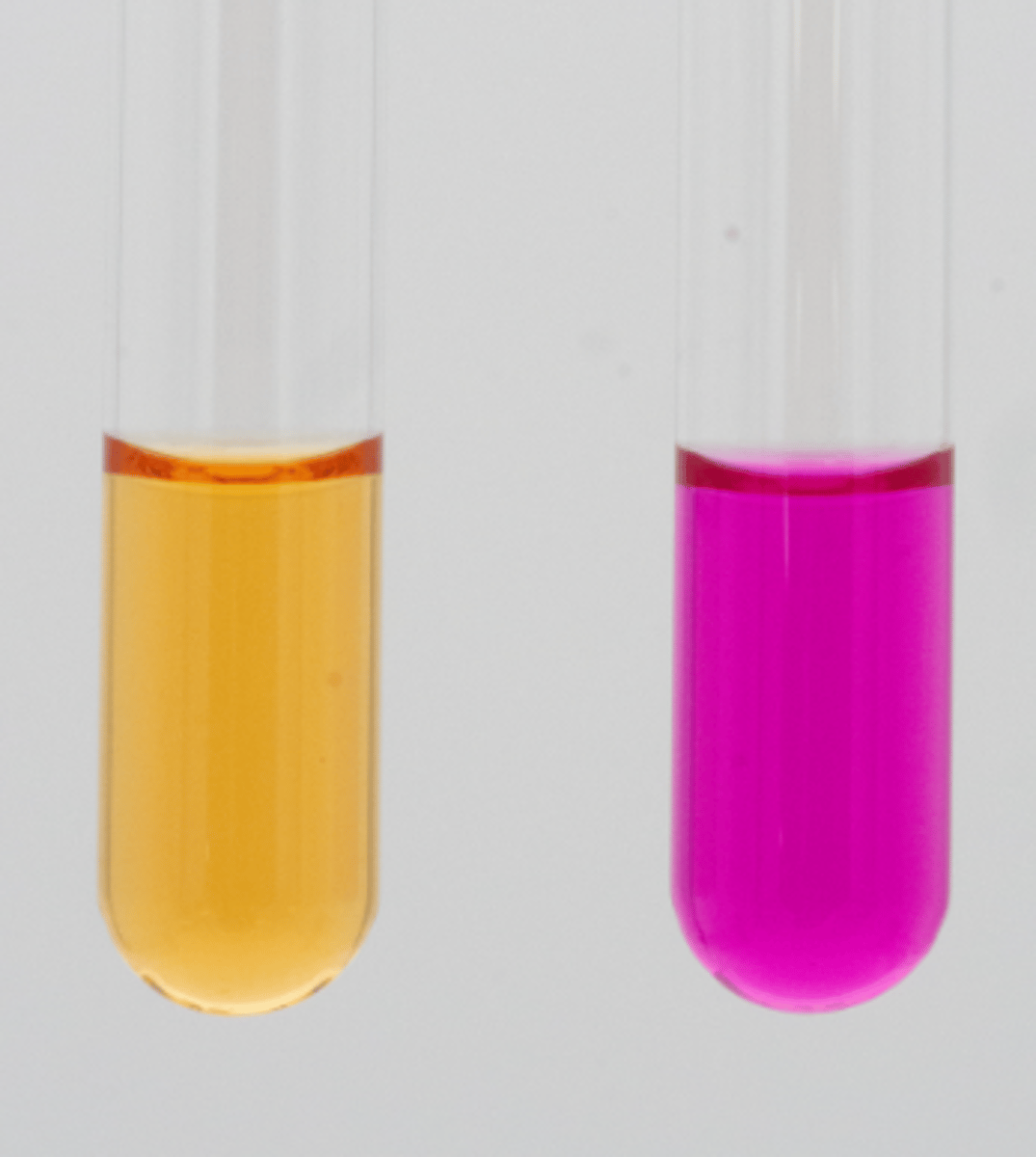
pt 1.
based on the phenol red carbohydrate results, we can make some logical conclusions regarding how our TSIA tube should look. In terms of sugars, the results from the carbohydrate broths indicate that our bacteria uses __. the use of glucose created __ that __ the pH, which would initially make the entire TSIA tube yellow.
glucose is the __ abundant sugar in TSIA at 0.1%, meaning it was depleted __ in slant where bacteria grew rapidly in the presence of oxygen. because our carbohydrate broths indicate the bacteria __ use lactose or sucrose, the bacteria will utilize the __ in the TSIA slant once glucose is depleted, which __ the pH and results in a red color.
based on the phenol red carbohydrate results, we can make some logical conclusions regarding how our TSIA tube should look. In terms of sugars, the results from the carbohydrate broths indicate that our bacteria uses glucose only. the use of glucose created acid by-products that decrease the pH, which would initially make the entire TSIA tube yellow.
glucose is the least abundant sugar in TSIA at 0.1%, meaning it was depleted quickly in slant where bacteria grew rapidly in the presence of oxygen. because our carbohydrate broths indicate the bacteria cannot use lactose or sucrose, the bacteria will utilize the peptones in the TSIA slant once glucose is depleted, which increase the pH and results in a red color.
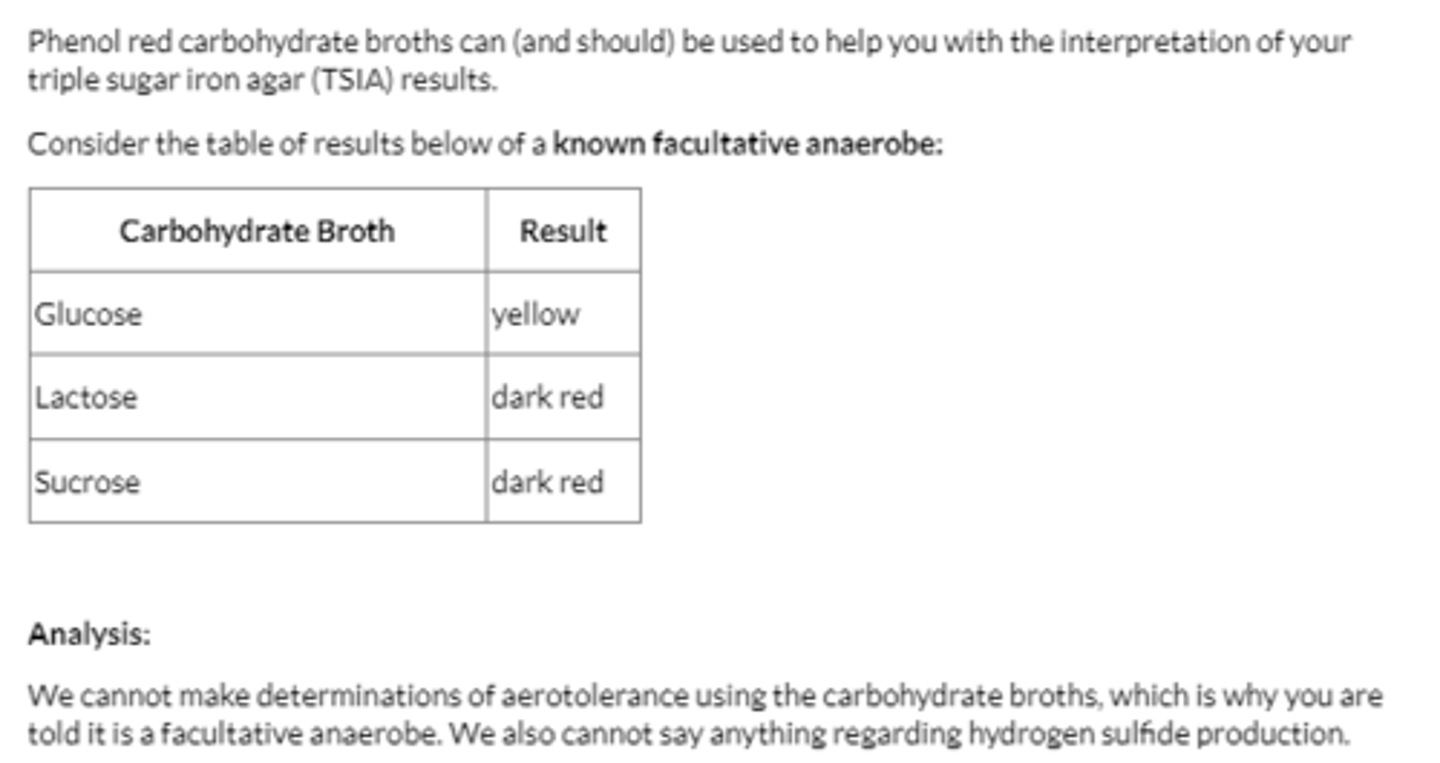
pt 2.
since breaking down peptones is an __ process, we can be confident this red color would be confined to the TSIA slant area only. the butt will remain yellow and acidic since this is an __ environment. Therefore, given our organism is a facultative anaerobe, we can conclude our result should be __ (red/ yellow)
since breaking down peptones is an aerobic process, we can be confident this red color would be confined to the TSIA slant area only. the butt will remain yellow and acidic since this is an anaerobic environment. Therefore, given our organism is a facultative anaerobe, we can conclude our result should be K/A (red/ yellow)
while conducting the nitrate reduction test, you add nitrate reagents a and b to an inoculated broth. after waiting 2-3 minutes, you notice that the broth remains colorless. what can you conclude at this point?
we cannot conclude anything at this point
wrong:
-nitrate reductase positive
-nitrite reductase positive
-nitrate reductase negative
while conducting the nitrate reduction test, you notice the durham tube is full of gas.
you add Nitrate reagents A and B to the inoculated broth. after waiting 2-3 minutes, you notice that the broth remains colorless. you add zinc dust and the broth remains colorless. What can you conclude at this point? select all that apply.
-nitrate reductase positive
-nitrite reductase positive
after observing phenol red carbohydrate broths, you determine that your organism is asaccharolytic.
the aerotolerance classification of this organism is __.
the TSIA result will be __/__
the aerotolerance classification of this organism is strictly aerobic.
the TSIA result will be K/NC
which of the following is NOT a product of urea hydrolysis?
nitrous oxide
__ acts as a catalyst which reduces nitrate (NO3-) into nitrite (NO2-).
zinc
while conducting the nitrate reduction test, you add nitrate reagents a and b to an inoculated broth. after waiting 2-3 minutes, you notice that the broth remains colorless. you add zinc dust and the broth quickly turns red. what can you conclude at this point?
nitrate reductase negative
nitrate reagent a contains __
sulfanilic acid
nitrate reagent b contains __
α-naphthylamine
together, nitrate reagent a and b indicate the presence of __
nitrite
select all true statements regarding hydrogen sulfide production in TSIA:
-hydrogen sulfide production occurs under acidic, anaerobic conditions
-when hydrogen sulfide production occurs, it is important to look at the corresponding phenol red carbohydrates, as H2S may obscure enough of the tube to make determination of lactose/sucrose difficult
based on the results from the table, explain how the TSIA tube should look for a facultative anaerobe organism.
from the results in the phenol carbohydrate broths, the bacteria had a positive carbohydrate reaction. the phenol red changed to the yellow, and the durham tube bubble resulted from the CO2 gas production. since there was CO2 present in the carbohydrate broth, one may presume there will be cracks or bubbles in the medium for the TSIA tube. in the carbohydrate broth, there was no lactose consumed, since there was no color change. for the TSIA tube, it should be yellow, which means it's acidic. the glucose and sucrose was consumed, which resulted in this yellow color, but not the lactose.
urea broth is a __ media containing __ (a food source), __ (a substrate) and __ (an indicator). this broth is used to test the enzyme __
if inoculated with a saccharolytic bacteria, the bacteria use __ to grow, producing __ by-products and the medium will become more __ (A), turning more __. if the bacteria are asaccharolytic, they will use __ for food, producing __ by-products and the media will turn __.
regardless of sugar use, if the organism produces the enzyme __, the medium will become highly __ (k) and the medium will turn __. this __ color is indicative of a positive urease test
urea broth is a differential media containing glucose (a food source), urea (a substrate) and phenol red (an indicator). this broth is used to test the enzyme urease
if inoculated with a saccharolytic bacteria, the bacteria use glucose to grow, producing acidic by-products and the medium will become more acidic (A), turning more yellow. if the bacteria are asaccharolytic, they will use peptones for food, producing alkaline by-products and the media will turn salmon.
regardless of sugar use, if the organism produces the enzyme urease, the medium will become highly alkaline (k) and the medium will turn hot pink. this hot pink color is indicative of a positive urease test
when bacteria utilize carbohydrates, they produce __ by-products, which __ the pH, designated by the short-hand abbreviation __.
when bacteria utilize proteins (peptones), they produce __ by-products, which __ the pH, designated by the short-hand abbreviation __.
when bacteria utilize carbohydrates, they produce acidic by-products, which decrease the pH, designated by the short-hand abbreviation a.
when bacteria utilize proteins (peptones), they produce alkaline by-products, which increase the pH, designated by the short-hand abbreviation k.
during a positive urease test, the presence of __ will turn the medium alkaline.
ammonia (NH3)
TSIA or __ is a type of __ microbiological growth medium. it is named triple sugar iron agar because it has four substrates, three sugars (__) as well as __. this media has two indicators, __ as a pH indicator, and __ as a H2S indicator. to determine the results, the slant which has __ conditions and the butt which has __ conditions must be examined
TSIA or triple sugar iron agar is a type of differential/selective microbiological growth medium. it is named triple sugar iron agar because it has four substrates, three sugars (glucose, lactose, and sucrose) as well as sodium thiosulfate. this media has two indicators, phenol red as a pH indicator, and ferrous sulfate as a H2S indicator. to determine the results, the slant which has aerobic conditions and the butt which has anaerobic conditions must be examined
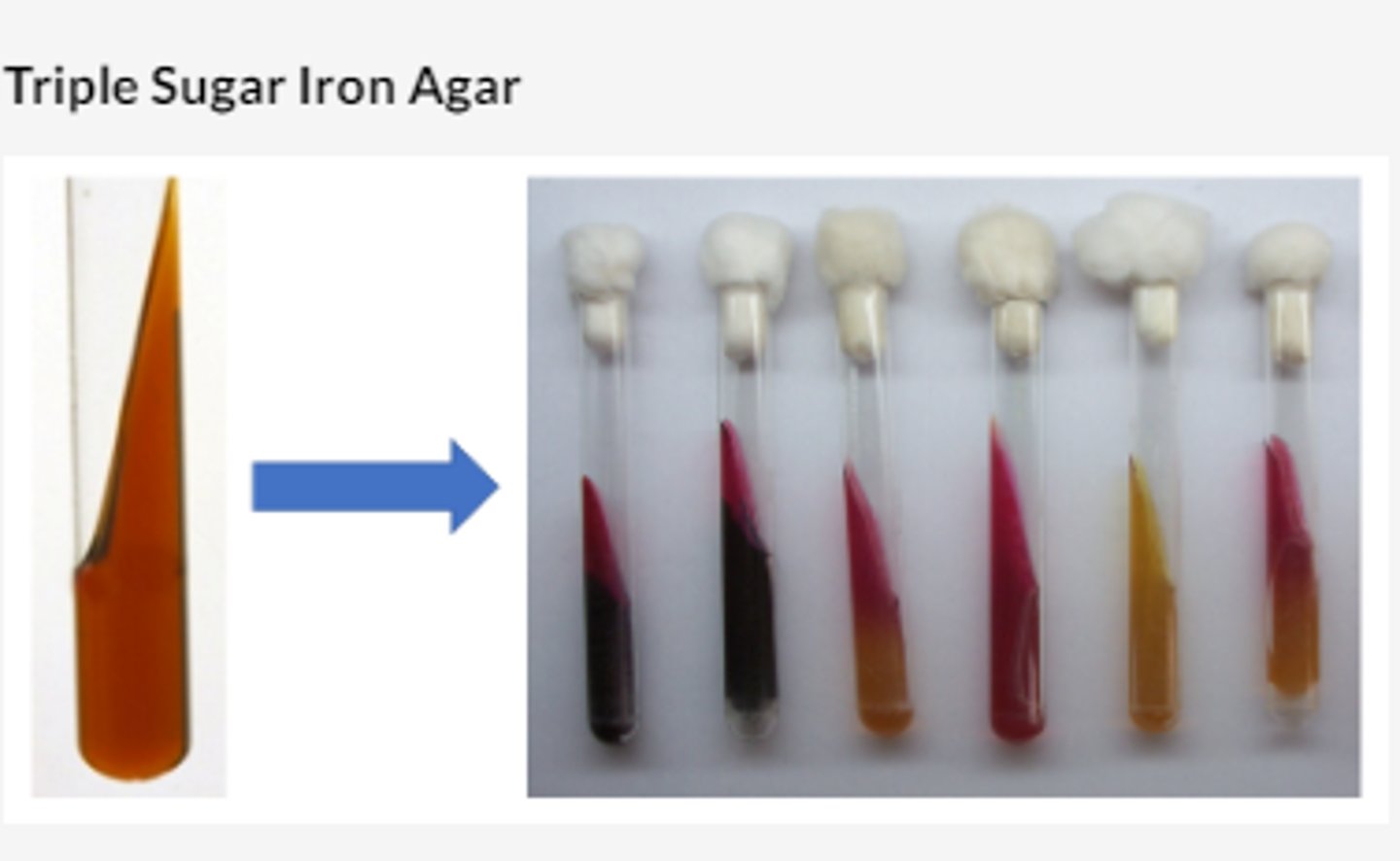
while conducting the nitrate reduction test, you add nitrate reagents a and b to an inoculated broth. you notice that the broth immediately turns red, indicating the organism is:
nitrate reductase positive
nitrate broth is a standard growth medium containing potassium nitrate. a durham tube is added to the test tube to capture __ gas. After incubation two reagents are added which react with __ to produce a __ color. nitrate reagent a contains __ while nitrate reagent b contains
nitrate broth is a standard growth medium containing potassium nitrate. a durham tube is added to the test tube to capture nitrogen gas. After incubation two reagents are added which react with nitrite to produce a red color. nitrate reagent a contains sulfanilic acid while nitrate reagent b contains alpha-naphthylamine
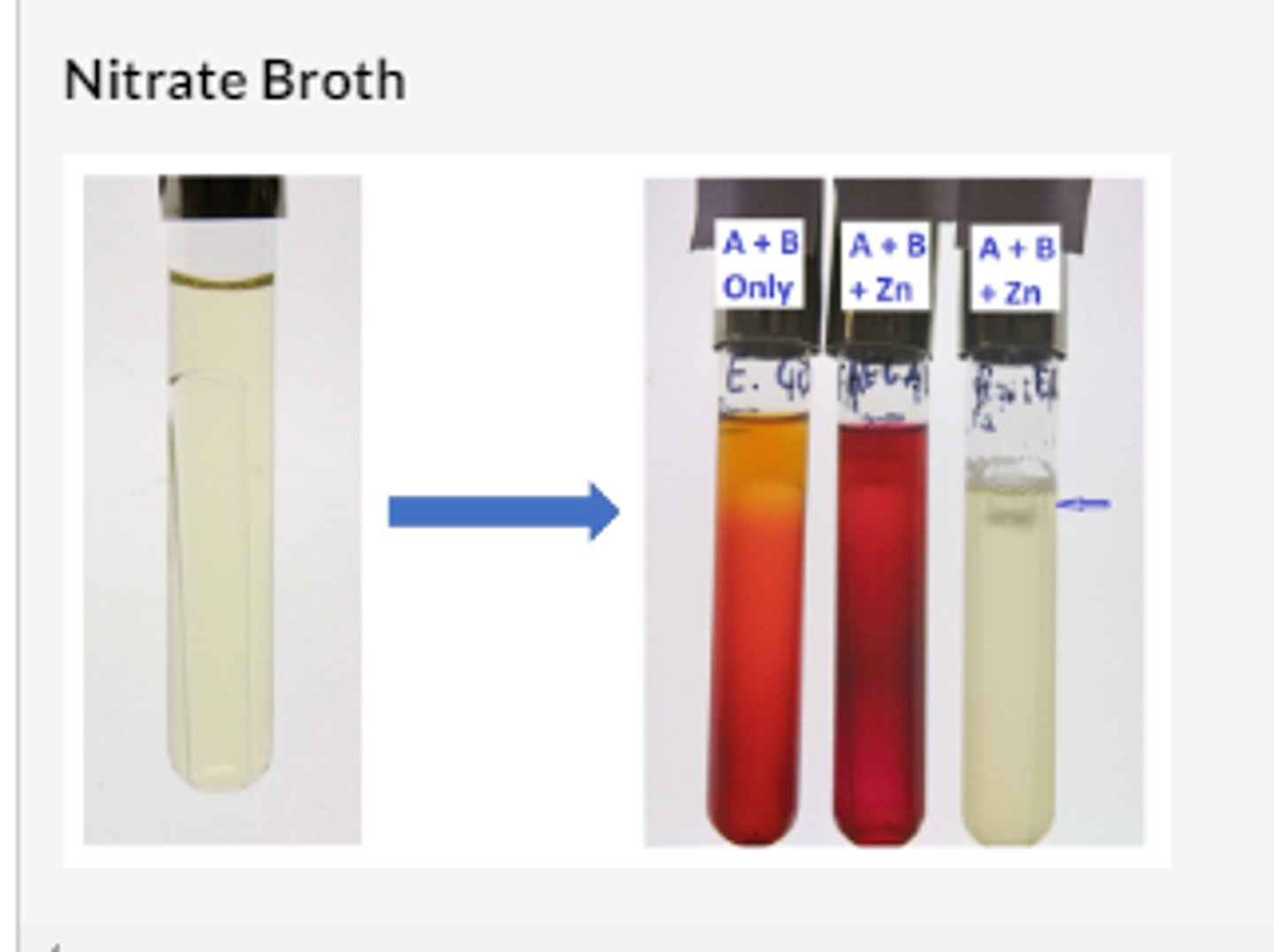
zinc's purpose
converts nitrate to nitrite.
nitrate reagent a purpose
react to nitrite in the broth.
nitrate reagent b purpose
react to nitrite in the broth.
durham tube purpose
capture nitrogen gas.
if the media doesn't change after adding nitrate A and B, we can immediately conclude that the organism is negative nitrate reductase. T/F
false